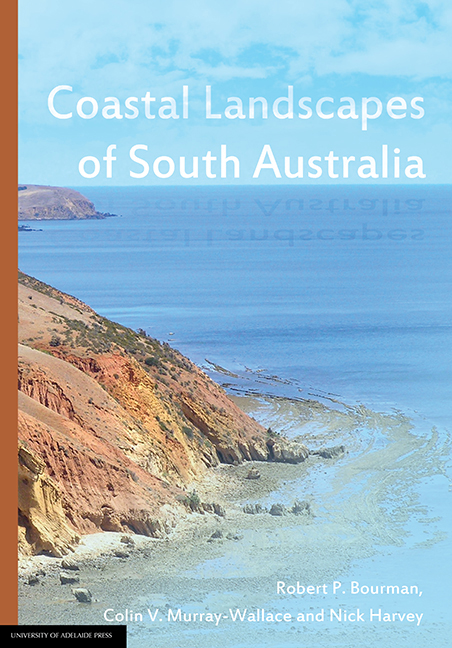Book contents
- Frontmatter
- Dedication
- Contents
- Preface
- Biographies
- Acknowledgements
- 1 Coastal landscapes of South Australia
- 2 The coast of metropolitan Adelaide
- 3 The Fleurieu Peninsula coast
- 4 The River Murray Estuary
- 5 The Coorong Coastal Plain and the Limestone Coast
- 6 The northern Gulf St Vincent tidal coastline (the Samphire Coast)
- 7 The Yorke Peninsula coastline
- 8 The northern Spencer Gulf coast
- 9 The Gulf Coast of Eyre Peninsula
- 10 The Bight Coast - West coast of Eyre Peninsula
- 11 Kangaroo Island
- 12 Explaining the coastal landscapes of South Australia - A synthesis
9 - The Gulf Coast of Eyre Peninsula
Published online by Cambridge University Press: 25 July 2017
- Frontmatter
- Dedication
- Contents
- Preface
- Biographies
- Acknowledgements
- 1 Coastal landscapes of South Australia
- 2 The coast of metropolitan Adelaide
- 3 The Fleurieu Peninsula coast
- 4 The River Murray Estuary
- 5 The Coorong Coastal Plain and the Limestone Coast
- 6 The northern Gulf St Vincent tidal coastline (the Samphire Coast)
- 7 The Yorke Peninsula coastline
- 8 The northern Spencer Gulf coast
- 9 The Gulf Coast of Eyre Peninsula
- 10 The Bight Coast - West coast of Eyre Peninsula
- 11 Kangaroo Island
- 12 Explaining the coastal landscapes of South Australia - A synthesis
Summary
Introduction
This chapter describes the coastline between Port Lincoln and Whyalla, the southern section of the Gulf Coast of Eyre Peninsula; the coast between Whyalla and Port Augusta is included in Chapter Eight on the northern Spencer Gulf shoreline. The eastern, sheltered Gulf Coast of Eyre Peninsula has a subdued morphological character in comparison with the exposed rugged, open ocean Bight Coast due to restrictions on oceanic swell, a much calmer wind and wave regime, and greater tidal influences. This has resulted in less development of modern sand dunes and aeolianite (lithified sand dunes), which on the Bight Coast are widespread and have been eroded into spectacular high cliffs. Ancient coarse crystalline rocks of the Gawler Craton, which underlie Eyre Peninsula and most of the Gulf Coast, have been essentially stable for millions of years. Tectonic deformation has been restricted to widespread uplift of the peninsula as a single unit, with more localised downfaulting near its eastern margin.
The shape and origin of Spencer Gulf is associated with many long-lived basement faults (Figure 9.1). The orientation of the coast southwest to northeast from Port Lincoln to Port Augusta is broadly related to tilted blocks and associated observed and inferred faults expressed in low escarpments. These are up to 70 km long with displacements of 100 to 150 m, separating uplands from coastal plains. Faulting has uplifted parts of the peninsula, such as the Lincoln and Cleve Uplands and the Blue Range, which merge with the eastern coastal plain that provides the backdrop to the coastline. In some locations, such as the shores of Boston Bay, the shoreline closely follows the Lincoln Fault. The faults are oriented to the northeast or to the east, and ancient structural features influence some of them. Faulting is continuing, as revealed by offset of the Late Pleistocene Pooraka Formation; there is also ongoing seismic activity. In places, faults are coincident with the coastline, whereas in others there is only an indirect influence, as the shoreline position is determined by the location of alluvial sediments derived from the fault-bounded uplands.
Most of the coastal plain comprises alluvial deposits overlying resistant Proterozoic rocks, which also produce rocky headlands and help to explain the more detailed character of the coastline (Figure 9.1). Weathering of the resistant rocks has added diversity to the coastline.
- Type
- Chapter
- Information
- Coastal Landscapes of South Australia , pp. 273 - 308Publisher: The University of Adelaide PressPrint publication year: 2016



